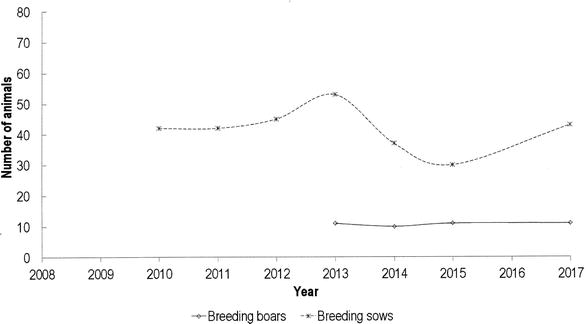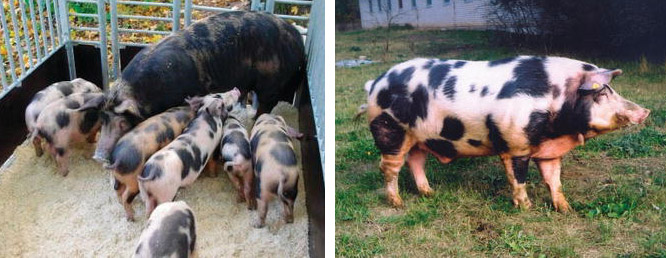History and the current status of the breed
Census of Lietuvos vietinė pig breed is presented in Figure 1. Presently, there are only two registered farms of Lietuvos vietinė pigs with about 43 breeding sows and 11 boars in the latest available status (December 2017).


Exterior phenotypic characteristics
The Lietuvos vietinė pig breed morphology information is summarised in Table 1. It is a middle-sized breed with wattles under the neck, and usually large black spots on the body, but colour variations include black and white, ginger, black and tricoloured (Figures 2 and 3). They have a friendly temperament. Being insensitive to the sun, these pigs are suitable for grazing.
Table 1. Summary of morphology information on Lietuvos vietinė pig breed.
| Measurement (average) | Adult male | Adult female |
|---|---|---|
| Body weight (kg) | 277.8 | 215.2 |
| Body length1(cm) | 166.6 | 156.7 |
| Height at withers (cm) | 88.6 | 78.3 |
| Number of teats (average) | 13.1 | 13.1 |
1 Measured from the tip of the nose to the starting point of the tail.

Geographical location and production system
Lietuvos vietinė pigs are conserved at the Centre for Farm Animal Genetic Resources in Coordination with Animal Science Institute, Lithuanian University of Health Sciences where the nucleus herd is maintained. Most of Lietuvos vietinė pigs are concentrated in this nucleus herd which is located in the central part of Lithuania, Baisogala, Radviliškis district.
Previously in Lithuania some small farms kept pigs outdoor during warm season. The experiments showed that at 14.3–18.7°C air temperature the weight at 60 days of age outdoor-born piglets was 16.9–32.6% higher than that of indoor-born piglets. In individual and group enclosures with shelters, they consumed, respectively, 18.2–8.7% less feed than indoor piglets of Lietuvos vietinė breed. However, the loss of outdoor piglets until weaning, particularly in group enclosures, was by 8.0–8.5% higher than that of indoor piglets. Nowadays, due to the African swine fever in wild boars and high veterinary standards for biosecurity, all domestic pigs in Lithuania should be kept strictly indoors. Consequently, the numbers of small pig farms and the numbers of local pigs have drastically decreased, because Lietuvos vietinė pigs are mainly intended for grazing. Currently, there is only a possibility for indoor rearing in semi-extensive conditions. Thus, Lietuvos vietinė pigs are kept, not for commercial purposes but for breed preservation and restoration and maintenance of herd stability by preserving biodiversity for future generations.
Productive performance
Reproductive traits
Sows of Lietuvos vietinė pig breed have 7.2–9.7 piglets of approximately 1.3 kg live body weight. Stillborn percentage of piglets is in between 7.4 and 16.1%, whereas piglet mortality rate until weaning in the considered studies varied between 14.6 and 31.1%. Duration of lactation is prolonged in comparison to modern intensive systems (to approximately 59 days), which leads to a higher piglet weaning weight (around 14 kg).
Growth performance
Due to big differences between studies with regard to the live weight range covered, we defined the stages for growth performance as lactation (regardless of how long it was), growing stage (from weaning to approximately 30 kg live body weight), early and middle fattening stages estimated between approximately 30–60 kg and 60–100 kg live body weight, respectively. In the considered studies, daily gain in lactation period was approximately 230 g/day. The average daily gain was 417 g/day in growing stage; 672, 588 and 644 g/day in early, middle and overall fattening stage; and around 470 g/day from birth to slaughter, which indicates slower growth rate and lesser intensity of rearing in the Lietuvos vietinė pig breed. In the context of the evaluation of growth performance, it is also of interest to observe the extreme values, because it can be assumed that the maximum figures exhibit the growth potentials of Lietuvos vietinė pigs in ad libitum conditions of feeding (≈698 g/day in overall fattening stage).

In considered studies, the information on feed intake and feed nutritional value were scarce, which limits the evaluation of growth potential. Average daily feed intake increased from 2.0 kg/day in early to 2.5 kg/day in middle fattening stage, whereas in the overall fattening stage, the average daily feed intake was 2.4 kg/day.
Body composition and carcass traits
In considered studies, pigs of the Lietuvos vietinė breed were slaughtered at approximately 200 days of age and between 57 and 108 kg live weight. Dressing yield was around 74% and lean meat content varied from 42 to 52%. The backfat thickness measured on the withers was approximately 49 mm, at the level of the last rib 29 mm and above gluteus medius muscle 28 mm. Muscularity measured as loin eye area averaged 29 cm2, and longissimus muscle thickness measured on live animals was approximately 38 mm.
Meat quality
In the studies reporting meat quality of Lietuvos vietinė pigs, pH measured in the longissimus muscle at 45 min and 24 h post-mortem were 6.3 and 5.4, respectively. The intramuscular fat content varied from 1.7 to 3.5%, and colour measured in CIE L*, a* and b* colour space was approximately 55, 15 and 7.6 for L*, a* and b*, respectively. The longissimus muscle from Lietuvos vietinė pigs has lower contents of cholesterol (39.6 mg/100 g) than those of lean conventional hybrids (44.24 mg/100 g).
Use of breed and main products
Due to the high fatness of Lietuvos vietinė pigs, implemented SEUROP grading system for carcass evaluation in abattoirs and import of cheap surplus meaty cuts of carcasses, Lietuvos vietinė pigs are not competitive on the market. Thus, their number is not increasing. Most of Lietuvos vietinė pigs are slaughtered and processed in the conventional pig production chain. Due to veterinarian restrictions related to the African swine fever, people refuse to keep growing pigs up to bacon condition for self-supply, although this was a common practice in the past among the people of the countryside. Most of the Lietuvos vietinė pigs from nucleus herd are used in the common pig production chain, whereas only the small part of pigs is being used for the production of home-made products. The traditional Lithuanian pork products produced are smoked backfat, including salt-cured backfat in the southeastern part of Lithuania, smoked hams and bellies, loins and different fresh and smoked dry sausages. The amount of unused carcass parts from Lietuvos vietinė pigs is small because Lithuanian cuisine knows different dishes not only from lean and fat pork but also from the offal, like meat jelly, blood pudding, liver pate and others.
Full text and references are available here: Lietuvos Vietinė Pig
Violeta Razmaitė, Rūta Šveistienė, Virginija Jatkauskienė, Remigijus Juška, Raimondas Leikus and Nina Batorek-Lukač (February 6th 2019). Lietuvos Vietinė (Lithuanian Indigenous Wattle) Pig, European Local Pig Breeds - Diversity and Performance. A study of project TREASURE, Marjeta Candek-Potokar and Rosa M. Nieto Linan, IntechOpen, DOI: 10.5772/intechopen.83768. Available from: https://www.intechopen.com/books/european-local-pig-breeds-diversity-and-performance-a-study-of-project-treasure/lietuvos-vietin-lithuanian-indigenous-wattle-pig



